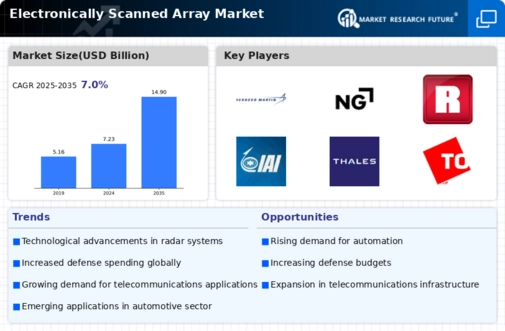Defense Spending Growth
In recent years, there has been a notable increase in defense spending across various nations, significantly impacting the Global Electronically Scanned Array Industry. Countries are investing heavily in advanced military technologies, including electronically scanned arrays, to enhance their defense capabilities. For example, the United States and several NATO allies are prioritizing the modernization of their radar systems. This surge in defense budgets is expected to propel the market to an estimated 14.9 USD Billion by 2035, reflecting a compound annual growth rate of 6.78% from 2025 to 2035, as nations seek to maintain technological superiority.
Technological Advancements
The Global Electronically Scanned Array Industry is experiencing rapid technological advancements, particularly in radar and communication systems. Innovations in digital beamforming and signal processing are enhancing the capabilities of electronically scanned arrays. For instance, the integration of artificial intelligence in these systems is improving target detection and tracking accuracy. As a result, the market is projected to reach 7.23 USD Billion in 2024, driven by increased demand from defense and aerospace sectors. This trend indicates a growing reliance on sophisticated electronic systems for national security and surveillance applications.
Global Connectivity Initiatives
Global connectivity initiatives are significantly influencing the Global Electronically Scanned Array Industry. As nations strive to improve communication infrastructure, electronically scanned arrays are becoming integral to next-generation satellite and terrestrial communication systems. These systems facilitate high-speed data transmission and enhance connectivity in remote areas. For instance, countries investing in 5G networks are likely to incorporate electronically scanned arrays to support the required bandwidth and reliability. This trend underscores the importance of advanced communication technologies in fostering economic growth and social development, further driving the market's expansion.
Commercial Applications Expansion
The Global Electronically Scanned Array Industry is witnessing an expansion into commercial applications, which is diversifying its growth potential. Industries such as telecommunications and transportation are increasingly utilizing electronically scanned arrays for enhanced communication and navigation systems. For example, the aviation sector is adopting these technologies for air traffic control and collision avoidance systems. This trend not only broadens the market's scope but also fosters innovation in developing tailored solutions for specific industry needs. As commercial applications grow, the market is expected to benefit from increased investments and research initiatives aimed at optimizing electronically scanned array technologies.
Rising Demand for Surveillance Systems
The demand for advanced surveillance systems is a critical driver of the Global Electronically Scanned Array Industry. As security concerns escalate globally, governments and private sectors are increasingly adopting electronically scanned arrays for monitoring and reconnaissance purposes. These systems offer superior performance in detecting and tracking multiple targets simultaneously. For instance, urban areas are deploying these technologies for public safety and traffic management. This growing emphasis on surveillance is likely to contribute to the market's expansion, as stakeholders recognize the value of real-time data and situational awareness in various applications.

















Leave a Comment